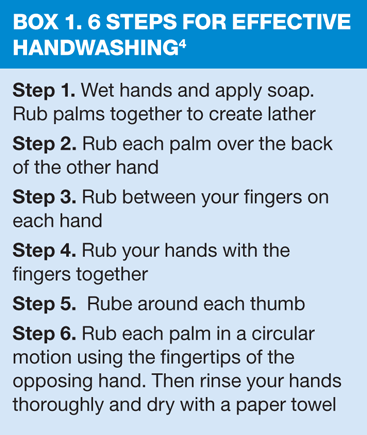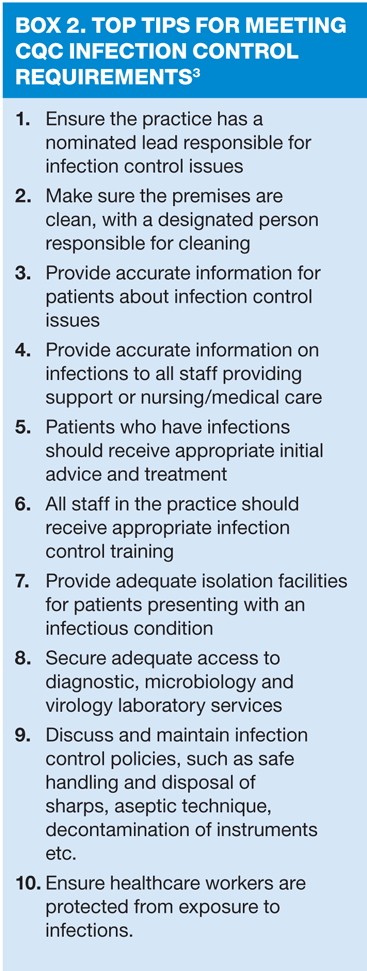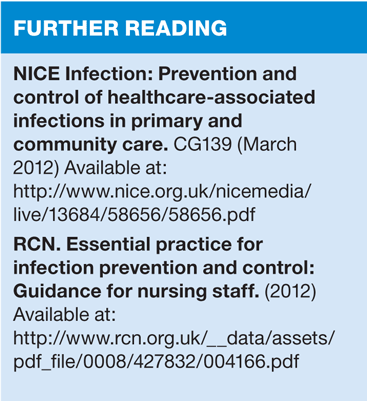Infection control in primary care
Mandy Galloway
Mandy Galloway
Editor
Even in apparently clean and hygienic practice premises there are pitfalls waiting to catch out the unwary: these salutary tales provide some useful for pointers for areas that may be in need of attention
Years ago, there was a story doing the rounds about a health authority inspection of a single-handed GP's surgery, which was next door to the doctor's home. The inspectors were surprised to see that there were no handwashing facilities in the surgery, but the doctor cheerfully explained that if he needed to wash his hands he could easily pop home to do so.
Whether or not this story was accurate or apocryphal, no one knows, and thankfully, things have moved on a great deal since then. Patients have a right to expect that their GP surgery will be clean and hygienic, and that they will not leave the premises with an infection they didn't come in with.
The essential standards set out by the Care Quality Commission (CQC) state that the CQC-registered practice should, as far as reasonable practicable, ensure that service users, staff and others who may be exposed to a healthcare associated infection (HCAI) are protected against identifiable risks.1
This means that practices should have effective systems in place to assess risks and prevent, detect and control HCAIs, and where necessary, ensure that they are treated appropriately.
Among the means of controlling risk are the maintenance of appropriate standards of cleanliness and hygiene in the practice premises, medical devices and materials that could become contaminated.
In practice, this means having policies in place for decontamination, regular cleaning (including deep cleaning), clinical waste disposal and sharps disposal. Staff should be trained in infection control policies, including handwashing, and infection control policies should be clearly displayed in the practice, including in consulting and treatment rooms.
However, as recent inspections have found, poor hygiene and breaches in infection control procedures still occur.2
In one practice, even though there was a clear decontamination policy, when inspectors looked at the training records of staff, they found that none had received any training on decontamination and infection control — although one nurse had attended an infection control conference a couple of years previously. This meant that staff did not have access to the most up to date information and guidance with regards to infection control procedures, which would help them to maintain a safe and clean environment.
The practice could not produce evidence of a maintenance policy or domestic cleaning plan. The practice carried out minor surgical procedures, but was not able to demonstrate that it had a cleaning schedule, or that any cleaning schedule had been followed after each procedure.
In another practice, an infection control audit had raised concerns about the practice nurses' room, such as the treatment couch being torn and floor covering being worn and ripped in places. Although the practice manager told inspectors that these issues were being rectified, there was no date set for completion.
In the same practice there was a large cupboard in the main hallway, unlocked and readily accessible to patients, which was used not only for storage of cleaning equipment and fluids, but also some medical equipment such as bandages, peak flow meters and dressing packs.
At a follow up visit to ensure that remedial action had been taken, some improvements — but not all — had been made to the nurses' room, and hazardous cleaning materials had been removed from the storage cupboard and placed under lock and key. But still no further infection control audit had been instigated.
Even when a practice appears to offer a clean, hygienic environment, the inspectors can find fault. For example, in one practice all the patients the inspectors spoke to were happy with the cleanliness of the practice. Their comments included, 'I can't fault the cleanliness of the surgery' and, 'The waiting room, toilet and consulting rooms are always clean and well presented, I've no concerns at all.'
The practice employed an external company to clean the practice, and the cleaning schedules in place included deep cleaning of the practice and the cleaning of soft furnishings.
Nonetheless, there were insufficient systems in place to reduce the risk and spread of infection. Staff had not received training in infection control or hand hygiene. Staff said they would 'use their common sense' when dealing with any issues such as the cleaning up of any bodily fluids.
The practice manager said staff were usually asked about their immunisation status as part of the recruitment process, but with only limited records available, the practice did not have systems in place to ensure that staff were free of, and protected from, exposure to infections.
Only limited information on hand washing and infection control were available in the patient and staff toilets, and in the consultation rooms.
Not all practices even look clean. In one, the carpet in the waiting room was heavily stained, and paint was peeling from the walls due to dampness in the part of the waiting room that was used as a children's play area.
Although these are specific examples from recent CQC checks on GP surgeries, there is evidence that the problems identified are not isolated. Infection control was also an issue in 85% of practices for which the Medical Protection Society (MPS) conducted clinical risk assessments in 2012.3
KEY RISKS3
Cleaning of premises
Of the practices visited in 2012, 41% (up from 37% in 2011) had risks associated with cleaning of the premises; this did not relate to the effectiveness or efficiency of those undertaking the housekeeping roles but rather the schedule of cleaning for each individual practice. Practices should ensure that they have a regular planned and monitored cleaning schedule which provides details about how the environment and equipment, such as chairs, examination couches and toys are to be cleaned and how frequently.
Floor mops should be regularly washed and changed periodically. Mops and buckets should be colour coded and different mops should be used to clean clinical and public areas. Mops should be hung to dry and should not be left wet in buckets.
Hand washing
A quarter of those practices visited had not provided staff with training on hand washing.3 Hand washing is the single most important step in reducing the spread of disease.
Ensure that all general practice staff receive appropriate training and use the six-step technique before and after direct contact with a patient.4 (Box 1) Replace any cloth hand towels with paper towels, as cloth towels are a recognised source of cross infection. Staff should also have access to suitable personal protective equipment such as gloves.
Clinical waste/Sharps
In 2012, 5.8% of practices visited by MPS had risks associated with clinical waste and the management of sharps3 — a considerable improvement on the 20% that had problems in 2011. Persistent problems include not using pedal operated clinical waste bins, clinical waste bins not being provided in the GP's consulting room or nurse treatment rooms, and inappropriate storage of clinical waste.
Practices must ensure they comply with the Control of Substances Hazardous to Health (COSHH) Regulations 2002, ensuring that all staff are instructed how to dispose of waste correctly and safely.5 All hazardous liquids, such as bleach, should be stored in a lockable cupboard.
COSHH also states that staff should ensure that needles are disposed of in the sharps containers at point of use. Sharps containers should be stored out of reach of children.
As the MPS found, clinical waste and sharps disposal — standards that should not be hard to meet — cause problems in practice.
Yet, at another inspection, the CQC noted: 'Most of the bins had been emptied, although one sharps bin was filled to above its maximum fill line.'
The healthcare workers most at risk from sharps injuries are nurses, because they are the ones who most commonly give injections and take blood in general practice. But other members of the practice team, including cleaners, are also at risk if sharps are not disposed of properly.6 Sharps injuries can occur at any stage — during use, after use but before disposal, between steps in procedures, during disposal, and while resheathing or recapping a needle. The risk of developing a potentially life-threatening disease following a sharps injury is small but significant: since the late 1990s there have been 20 documented cases of healthcare workers, including nurses, contracting hepatitis C infection, and five cases of HIV transmission from percutaneous exposure.
All healthcare workers should be immunised against hepatitis B infection, and should be shown to have a serological response to the vaccine.7 It should go without saying that this should be documented in practice records.
Specimen handling
A common problem but one to be avoided is the handling of specimens by reception staff. Patients are not the experts in ensuring sample bottles are not contaminated, but in 2012, 44% of practices had risks associated with specimen handling, compared with 40% visited in 2011.3
As part of the practice's infection control policy, reception staff should not touch patient specimens, and samples in inappropriate containers should not be accepted. Nurses — and GPs — should ensure that they issue the patient with a labelled specimen container when requesting a specimen; this should reduce the number of specimens being presented in unsuitable and unlabelled containers. It will also prevent the need for decanting samples. A box could be provided at the reception desk for patients to leave their samples, which can then be passed directly to the nursing staff.
Dealing with spillages
Spillage kits were not available in more than a quarter (26.7%) of the practices visited in 2012.3 Ensure that the practice provides spillage kits, either purchased or made up in-house, for dealing with spillages such as body fluids, blood and mercury (if applicable). Contact your local infection control nurse about requirements for the safe cleaning of hazardous substances.
Training
Just under 32% of practices visited by the MPS had not provided staff training on infection control.3 It is essential that training is provided, and — to satisfy CQC inspectors — that a record of it is kept to demonstrate compliance with this standard.
CONCLUSION
Although it is the responsibility of the GP who has registered with the CQC to comply with its standards, everyone in the practice has a role to play in maintaining high standards of cleanliness, hygiene and adhering to infection control policies. If you have doubts about these standards in your own practice, raise them — in a non-confrontational way — with the practice manager and other members of the team at a routine practice meeting. Because while common sense sees most of us through our everyday business, when it comes to infection control, common sense is not enough.
REFERENCES
1. Care Quality Commission: Guidance about compliance. Essential standards of quality and safety (2010). Available at: http://www.cqc.org.uk/sites/default/files/media/documents/gac_-_dec_2011_update.pdf
2. Care Quality Commission. Latest checks (Doctors/GPs). Available at: http://www.cqc.org.uk
3. Medical Protection Society. Infection control. Practice Matters 2012;1(4):12-13 Available at: http://www.medicalprotection.org/uk/practice-matters/issue-4/risk-alert-infection-control
4. Ayliffe GA, Babb JR, Quoraishi AH (1978) A test for 'hygienic' hand disinfection. Journal of Clinical Pathology. 31, 10, 923-928.
5. Control of Substances Hazardous to Health (COSHH) Advice available from website: http://www.hse.gov.uk/coshh/
6. Royal College of Nursing (2011) Sharps safety. Available at: http://www.rcn.org.uk/__data/assets/pdf_file/0008/418490/004135.pdf
7. Public Health England. Hepatitis B: Information and Guidance in the Occupational Setting. Available at: http://www.hpa.org.uk/webc/HPAweb&HPAwebStandard/HPAweb_C/1195733772505
Related articles
View all Articles


